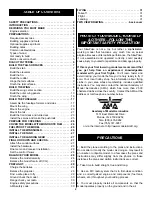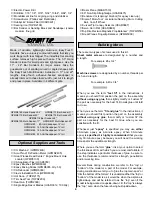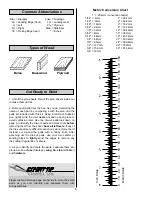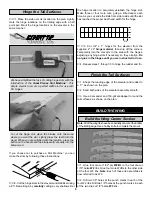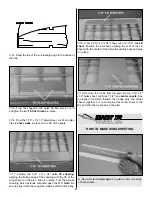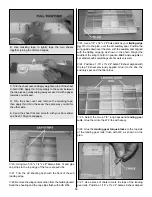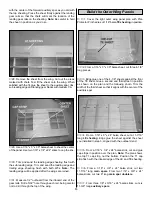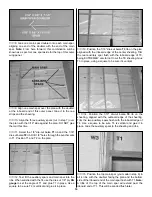
5. You must check the operation of the model before every
flight to ensure that all equipment is operating and that the
model has remained structurally sound. Be sure to check
nylon clevises or other connectors often and replace them if
they show signs of wear or fatigue.
6. If you are not already an experienced R/C pilot you must
fly the model only with the help of a competent, well
experienced R/C pilot.
Remember: Take your time and follow directions to end
up with a well-built model that is straight and true.
Please inspect all parts carefully before starting to
build! If any parts are missing, broken or defective, or if
you have any questions about building or flying this
airplane, please call us at (217) 398-8970 or e-mail us at
productsupport@greatplanes.com. If you are calling for
replacement parts, please reference the part numbers
and the kit identification number (stamped on the end
of the carton) and have them ready when calling.
Congratulations and thank you for purchasing the Great
Planes SlowPoke. The SlowPoke is perfectly suited for
small field flying and because of its size is easy to transport.
Great Planes has taken a simplified approach to the
SlowPoke's design by incorporating a CAD designed
airframe with the "stick style" construction of yesteryear.
The SlowPoke was intentionally designed for easy 3-channel
flying, a small displacement engine and a light wing loading.
When finished, the SlowPoke is quite capable of slow,
leisurely flight without the worry. Its styling is reminiscent of
the Golden Age of aviation and very pleasing.
Items in parentheses (OSMG2691) are suggested part
numbers recognized by distributors and hobby shops and
are listed for your ordering convenience. GPM is the Great
Planes
®
brand, TOP is the Top Flite
®
brand, and HCA is the
Hobbico
®
brand.
❏
4 Channel Radio with 3 Servos
❏
Engine; See Engine Selection
❏
Spare Glow Plugs
(O.S.
®
#8 for most 2-stroke engines, OSMG2691)
(O.S.
®
Type-F for most 4-stroke engines, OSMG2629)
❏
Propeller (Top Flite Power Point
®
) Refer to your
engine’s instructions for proper size
❏
Top Flite Super MonoKote
®
covering (Approximately 2
rolls); See Covering (page 26)
❏
Fuel-Proof paint; See Fuelproofing (page 26)
❏
12" Medium Fuel Tubing (GPMQ4131, 3’)
❏
1/4" Latex Foam Rubber Padding (HCAQ1000)
❏
4 oz. Fuel Tank (GPMQ4101)
❏
(2) 3" Lightweight Wheels (DAVQ5030)
❏
(4) 5/32" Wheel Collars (GPMQ4306)
❏
(1) 3/32" Wheel Collar (GPMQ4303)
❏
1-1/2" Spinner (GPMQ4500 – white)
❏
Pilot (WBRQ2475) Scale Sportsman Pilot used in prototype.
❏
(1) 1-1/4" Tail Wheel (GPMQ4242)
These are the building tools, glue, etc. that we recommend
and mention in the manual.
❏
1 oz. Thin Pro
™
CA (GPMR6002)
❏
1 oz. Medium Pro
™
CA+ (GPMR6008)
❏
1 oz. Thick Pro
™
CA– (GPMR6014)
❏
Pro CA Accelerator (GPMR6035)
❏
6-Minute Pro
™
Epoxy (GPMR6045)
❏
30-Minute Pro
™
Epoxy (GPMR6047)
❏
Pacer Formula 560 Canopy Glue (PAAR3300)
❏
#1 Hobby Knife Handle (HCAR0105)
❏
#11 Blades (HCAR0311, 100 Qty.)
❏
X-Acto
®
Razor Saw (XACR2531)
❏
Hobbico Builder’s Triangle Set (HCAR0480)
❏
Small T-pins (HCAR5100)
❏
Medium T-pins (HCAR5150)
❏
Great Planes Plan Protector
™
(GPMR6167)
❏
Chalk
❏
Masking Tape
❏
10-32 Tap and Drill set (GPMR8104, drill bit included)
Building Supplies and Tools
Required Accessories
PREPARATIONS
Engine Selection
There are several engines that will work well in the
SlowPoke, but for maximum performance we recommend
an O.S.
®
.15 LA or .20 FP
™
or if you prefer a 4-stroke, an
O.S. .26 Surpass works well.
DECISIONS YOU MUST MAKE
INTRODUCTION
NOTE: We, as the kit manufacturer, provide you with a
top quality kit and great instructions, but ultimately the
quality of your finished model depends on how you build
it; therefore, we cannot in any way guarantee the
performance of your completed model, and no
representations are expressed or implied as to the
performance or safety of your completed model.
3
Summary of Contents for SlowPoke
Page 6: ...6 DIE CUT PATTERNS...
Page 32: ...TWO VIEW...


